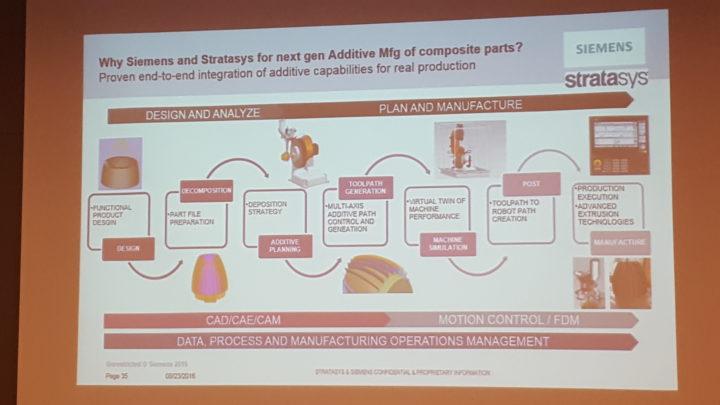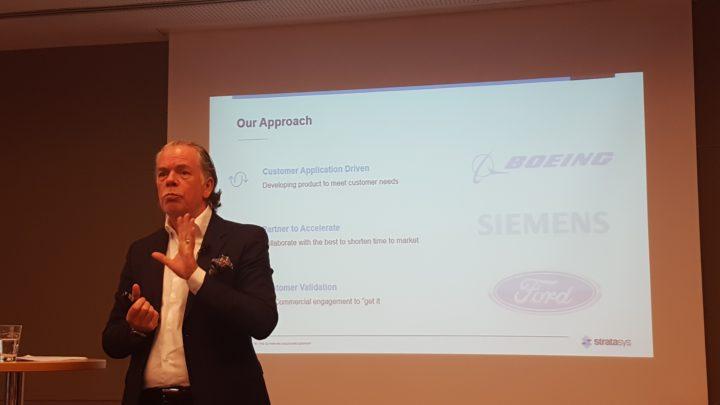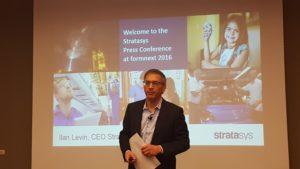Stratasys Works with Siemens Toward Use-Case Technology Development with Real Solutions via Additive Manufacturing
“We’re taking a quantum step forward,” Andy Middleton, President of Stratasys EMEA, began this morning’s press conference.
Big statements are nothing new for Stratasys, which in the spring began the press event unveiling the J750 multi-material 3D printer with the bold claim that “We’re at the beginning of something that’s going to shake up the world.” Any company that feels itself in a place to not only invent a technology in the first place but to reinvent it some years later is certainly one to keep an eye on – and to look through the claims, parting the curtains to discover what the actual news of a given day is.
Stratasys’ recently appointed CEO, Ilan Levin, took to the mic to discuss both his and the company’s histories regarding 3D printing.
“I’ve been in this business a good number of years,” he told those of us gathered. “I’ve watched it change and grow.”
Levin has been a director of the company since 2000, drawing experience from Objet both before and after its merger with Stratasys. Since his appointment to CEO in July, Levin has been working to restructure Stratasys to fit into the new shape of the 3D printing industry.
“I felt that the industry and everything in it was still ahead of us,” he noted. “Everything is still in front of us. I very much wanted to be a part of that, I wanted to realign Stratasys and keep our focus there.”
A growing trend this year has been to delve beyond the previously over-hyped capabilities of 3D printing as the technology stands today. Many companies, Stratasys among them, are working to distance themselves from the overblown claims of the past; while terms like “game-changing” are still regularly bandied about, reality is taking more of a claim as to today’s capabilities and where we might actually see the technology progress and be used within the next handful of years. Levin drew focus toward two distinct market trends:
- Natural technology
- Making additive manufacturing meaningful
Accessibility has been on the rise, with entry-level systems, such as those from MakerBot, now familiar to consumers, along with software ecosystems and accessible materials. This is all leading the technology to have a broader reach, such as in the prosumer segment. With that expansion of adoption comes the rising need to make the technology meaningful; there is largely no need anymore to evangelize to potential customers about what additive manufacturing has to offer, as many employ it already.
“Many early adopters have already gone knee-deep in the technology,” Levin explained. “They’re looking at how they can integrate what the technology can afford them.”
This all boiled down to the need to expand beyond the one-size-fits-all technologies that we’ve seen so far, in which a company would develop and present a technology, leaving it to customers to figure out what then to do with it. Now, Levin stressed, we need to “speak use-case language” to create specialized solutions for business-critical solutions. With Stratasys having been in business for decades now, some customers have been using their technology for 20 years – and it’s time to listen to what they need to create new solutions.
- A composite component made via the Robotic Composite Demonstrator
- This piece is made of carbon fiber-reinforced nylon
This year, Stratasys has introduced its two new technology demonstrators, as well as the J750. These technologies all serve to present new options and capabilities that have not yet been seen before. With the Robotic Composite Printer multi-axis robotic arm, users gain geometric freedom and the ability to integrate composite materials, while the Infinite Build Demonstrator allows for the creation of exceptionally large parts, going beyond the limits of a Z-axis. These demonstrators were both developed through collaborations with key customers, with Boeing and Ford contributing to the Infinite Build Demonstrator. For its part, the J750 allows for accuracy and full-color capabilities valued in such applications as medical modeling and full-color final prototyping.
“We are smart in developing technology,” Middleton stated next. “Our customers are much smarter than we are in developing applications.”
Focusing on key collaborative efforts such as that with Airbus – in which Middleton notes that the 1,000 3D printed parts we see now in use on the Airbus A350 XWB will turn to 3,000, 5,000, even 10,000 parts (though admitting that “I don’t know what that timeline is going to be”) – Stratasys’ AM offerings allow for enhancements in the supply chain, weight reduction, and customization, leading together to a major savings in inventory. Additional case studies noted included work with Volvo Trucks, Safilo, and Schneider Electric.
“It’s no longer sustainable to build a product, release a technology to market and hope the customers will figure out what to do with it,” Middleton explained. “The companies that become leaders will be those who realize that it’s a joint effort. Going forward, you will see that leading companies such as Stratasys will only continue to lead when we encourage this level of intimacy with our users.”
Today, Stratasys took the opportunity to highlight their demonstrators, not only explaining that they are targeting the second half of 2017 to bring Infinite-Build to Europe, but announcing a major partnership with Siemens. The formal announcement, made today, presents a closer look at the Robotic Composite 3D Demonstrator, which Stratasys and Siemens note offers composite parts created with a strength-to-weight ratio that had not been possible before, thanks in large part to the eight-axis robot with a single head.
 Andreas Saar, Siemens PLM’s Vice President and Head of Additive Manufacturing Program, stated:
Andreas Saar, Siemens PLM’s Vice President and Head of Additive Manufacturing Program, stated:
“As we believe, partnerships are the way of reinventing technology, bringing game-changes to the world. Digitalization is transforming business models.
“When we started our partnership, we were thinking about what we can do together. … What can we do new, what can we do that’s a game-changer? With our vast experience in robotics and Stratasys’ vast experience and understanding of additive manufacturing, we thought there must be a way to bring these technologies together. Additive manufacturing and advanced robotics together lead to intelligent automation, which I do believe will change technology.”
Aspects of the partnership involve Siemens’ product lifecycle management (PLM) software systems to drive the Robotic Composite 3D Demonstrator. While the robotic manufacturing system could do with a catchier name (and more clearly understood definitions of the axes on which it operates, with one canny member in the gathered press counting it as a seven-axis robot), the benefits it seems to offer do stand on their own merits. Noted aspects of the system include Speed (faster build time), Flexibility (better reachability, print large parts), Efficiency (no support structures), and Quality (better surface).
Siemens technology coming into play here includes NX to drive the system and Sinumerik CNC to control it. Automation is key to upcoming technology, as is the use of innovative composite materials.
“Digitalization will completely change our business,” Saar stated. “Completely.”
The press conference wrapped up with some almost uncharacteristic humility from one of the industry’s largest players.
“There’s a lot more smart people outside of Stratasys than inside of Stratasys,” Middleton said. “Partnering up will be our way of the future. The days of one-size-fits-all in the 3D printing world are days of the past. We will be and are currently delivering customized solutions for specific applications.”
Aside from this morning’s press conference, Stratasys has announced at formnext their newest 3D printer, the large-format Fortus 900mc, along with new FDM Nylon 6 material; commercial global availability of GrabCAD Print software; and a collaboration with SAP SE to establish a global network of 3D printing co-innovation labs. Stay tuned for more on those shortly!
[All photos: Sarah Goehrke for 3DPrint.com]Subscribe to Our Email Newsletter
Stay up-to-date on all the latest news from the 3D printing industry and receive information and offers from third party vendors.
You May Also Like
Air Force Awards Fortius Metals $1.25M to Qualify 3D Printing Wire for Hypersonic Applications
AFWERX, part of the US Air Force Research Laboratory (AFRL), awarded a Direct-to-Phase II Small Business Innovation Research (SBIR) contract worth $1.25 million to Colorado’s Fortius Metals, to accelerate qualification...
US Air Force Awards JuggerBot $4M for Large-format Hybrid 3D Printing
Large-format 3D printer manufacturer JuggerBot has received a $4 million grant to develop a large format 3D printer, courtesy of the Under Secretary of Defense, Research and Engineering Manufacturing Technology...
Where Have All AM’s Unicorns Gone?
In the rapidly evolving world of 3D printing, startups valued at over a billion dollars, known as unicorns, once seemed as fantastical as the mythical creatures themselves. While a few...
How My Childhood Fascination with Planes Led to Investing in 3D Printing
My fascination with aerospace started young, and I started studying planes–identifying them in the sky and learning everything I could about how they work. Fast forward to my first week...





































